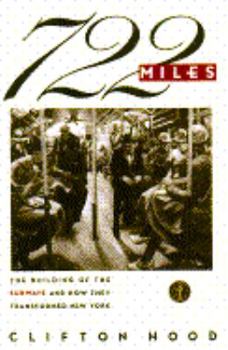722 Miles: The Building of the Subways and How They Transformed New York
Select Format
Select Condition 
Book Overview
When it first opened on October 27, 1904, the New York City subway ran twenty-two miles from City Hall to 145th Street and Lenox Avenue--the longest stretch ever built at one time. From that initial... This description may be from another edition of this product.
Format:Hardcover
Language:English
ISBN:067167756X
ISBN13:9780671677565
Release Date:January 1994
Publisher:Simon & Schuster
Length:335 Pages
Weight:1.40 lbs.
Dimensions:1.0" x 6.4" x 9.5"
Customer Reviews
5 ratings
Not A Tourist Guide?
Published by Thriftbooks.com User , 20 years ago
In response to other reviewers: this book is not MEANT to be a tourist guide, it IS, however, an academic study, and a very good one indeed. For those who did not enjoy the book, because of it's lack of pictures, perhaps the problems lie with the reader rather than the author?
a good political history
Published by Thriftbooks.com User , 21 years ago
my only criticism of this book is that 1/3 of it is of footnotes. when the book ended, there was too much reference material here. the jackson heights subway line info is interesting as it is not common to focus on an area outsideof manhattan as much. a good read. the poltical machinisms to get the work done are a worthy read.
Doesn't cover everything, of course.
Published by Thriftbooks.com User , 22 years ago
As another reviewer mentioned, this isn't a tourist guide. There aren't that many maps, and the ones present do not show stops. Aside from the creation of new suburbs such as Jackson Heights, there isn't a whole lot of discussion of how the subways affected neighborhoods after they were built, especially after cars began to take over.The main point this book makes is how the combination of enforced low fares and the perception of rapid transit as a business rather than a public service caused the subways' decline. The beginning of the book describes some of the engineering problems involved in building subways in New York. I would have liked to have seen more of that, especially for later, non-IRT subways; diagrams of the terrain in question would have been interesting.Anyway, the book has to stop somewhere. For all that's left out, the discussion of people and politics, and of how things could have turned out differently, is fascinating.
Very nicely written.
Published by Thriftbooks.com User , 23 years ago
Hood demonstrates the power of doing ones Homework . Excellent reading.
An Invaluable work for city scholars
Published by Thriftbooks.com User , 25 years ago
In you are looking for a tour guide of New York's vast subway system, or a concise timeline of its construction and equipment, look elsewhere. What Clifton Hood has produced is a political history of the subway which should be read by every student of New York history and every person who wants to understand better the workings of New York City politics today. The reader will find such familiar personages as Boss Tweed and Fiorello LaGuardia, but will also read about John F. Hylan, mayor from 1918-1925. Hylan's is hardly a household name in popular New York history--he is known instead to the relative handful of people who delve into the recesses of Big Apple politics of the early 20th century. In 722 Miles, Hood places Hylan in his proper place as the man who politicized the NYC transit system and, in so doing, set the stage for the long deterioration of the system which is only now being reversed. I could quibble with various aspects of Hood's book--perhaps he focuses too much attention on one or another story relatively peripheral to the system's development while treating too lightly other threads. For example, he doesn't visit the influence of the BRT (later BMT) system until it became involved in the subway building contracts of 1913. Additionally, to address the concerns of an earlier reviewer, there are lapses in editing which are odd in so heavily researched and footnoted a work. For example, at one point (using my hardbound copy as reference), Hood described a laborer's pay on the first subway as being $2.00 or $2.25 PER HOUR, a princely sun at the time, when he clearly meant PER DAY. Elsewhere, in describing the distastrous Malbone Street accident of 1918, he twice specifies that the fully wrecked car was number 109, when it is well known to have been 100--an insignificant detail, perhaps, but one which causes one to wonder what others details might have been mistated.All in all, however, these lapses do not dim Hood's achievement in producing the only modern work of its kind, a compelling and perceptive look at the way New York City politics have interacted with perhaps its most significant public work.






